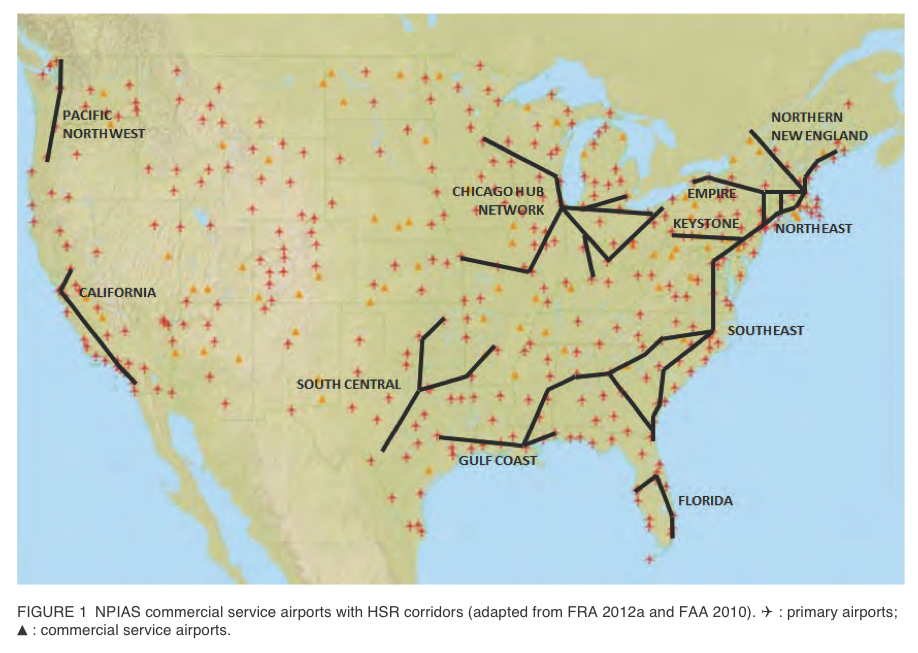AIRPORT COOPERATIVE RESEARCH PROGRAM
Introduction
In accommodating surging intercity transportation demand during an era of unprecedented environmental concern, understanding the environmental trade-offs and co-benefits of air and high-speed rail (HSR) transportation is critical for producing high-quality information for decision makers. An analysis of the environmental impacts of air and HSR competition or complementary service in a region is only as strong as the uncertainty that is introduced by an analytical framework that does or does not (1) accurately account for the conditions under which future U.S. systems will operate, (2) model these conditions in a way that is true to actual operation, or (3) understand the potential future scenarios for air and HSR transportation. This is additionally complicated by institutional processes that preclude certain methodological approaches. Environmental assessments of these systems consider a comprehensive list of human health, ecosystem services, climate change, and resource depletion impacts from deploying different modes such that a broad suite of concerns are assessed simultaneously, leading to early identification of unintended trade-offs and the opportunity for cost-effective strategies that lead to environmental burden reduction. As the United States begins to ask questions about long-distance transportation futures, an integrated framework is desirable to guide transportation planning and investment decisions toward solutions that lead to sustainable travel.
In the following chapters, published literature on environmental assessments of air and HSR systems is synthesized. Academic publications and government studies are the focus of the synthesis, with nonprofit and private sector organizations discussed where relevant. In the literature, the focus is on government-driven environmental comparisons and academic literature. Government-driven environmental comparisons are in the form of National Environmental Policy Act (NEPA) studies. From these studies, the role of NEPA in environmental assessments and how the spatial incompat- ibilities of air and HSR systems and the scope of purpose and need statements complicate the full consideration of air and HSR as alternatives are explored. Academic studies are present in the literature focusing on one or a suite of pollutants. The literature synthesis finds many existing research studies that focus on criteria air pollutants, noise, land use, energy, and greenhouse gas (GHG) emissions, with the latter two being the focus of much of the academic work. Significant literature and methods provide a solid footing for deploying a consistent and comprehensive framework for air and HSR environmental assessment in the United States; this solid footing is not without gaps in the literature. These gaps are both procedural and analytical, such that they can be filled through research extensions, novel methods, or the appropriate tools or data. This document has been developed to identify these gaps and provide direction from the existing literature for how future environmental assessments of long-distance travel can be structured to provide the highest quality information for decision makers.
The literature synthesis categorizes air and HSR assessments into two approaches: attributional and consequential (Ekvall and Weidema 2004). Attributional approaches are designed to allocate the energy and environmental outcomes of air and HSR systems to passenger travel, a trip, or vehicle travel, considering average data over the long run of the system. Attributional assessments consider the system at a fixed point in time and evaluate backward in their allocation of effects. Consequential approaches, which the government environmental review process uses, are designed to assess the environmental impacts of decisions or changes to the long-distance transportation system and use marginal impacts in assessments. Consequential assessments are not for a given operational profile but rather for an operational profile that results from the decision to alter long-distance transportation service. Changes might include the implementation of an HSR system, new pricing policies for passengers, and a restriction of operations at a particularly busy airport, among others. As a result, consequential assessments involve assessing mode shifting and the interplay between multimodal travel (Givoni 2007; Chester and Horvath 2012; Behrens and Pels 2012), as well as mathematically determining the resulting environmental effects.
Both approaches have independent value. Attributional assessments are valuable for understanding the critical factors that in long-run average conditions lead to the greatest impacts for that mode. Consequential assessments are valuable for understanding how a policy or decision will affect long-distance travel and lead to corridor or regional environmental effects and how that may contribute to large-scale environmental goals. The following chapter addresses complexities in air and HSR environmental assessments and how they affect attributional and consequential assessments.
Read full report (PDF) here: Environmental Assessment of Air and High-Speed Rail
About The Airport Cooperative Research Program (ACRP)
www.trb.org/ACRP
”The Airport Cooperative Research Program (ACRP) is an industry-driven, applied research program that develops near-term, practical solutions to problems faced by airport operators. ACRP is managed by the Transportation Research Board (TRB) of the National Academies and sponsored by the Federal Aviation Administration (FAA). The research is conducted by contractors who are selected on the basis of competitive proposals.”
Tags: ACRP, Air, Airport Cooperative Research Program, Aviation, Environmental Assessment, High Speed Rail, TRB







 RSS Feed
RSS Feed